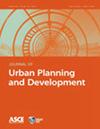轨道交通竞争下建筑环境对公交出行率的影响
IF 1.9
3区 工程技术
Q3 ENGINEERING, CIVIL
引用次数: 0
摘要
近十年来,发展中国家轨道交通的快速建设对公交运输产生了很大的影响,造成了公共交通资源的浪费和公交与轨道交通的无效竞争。因此,探索如何结合建筑环境的影响和它们之间的竞争,促进公交和轨道交通的融合发展就显得尤为重要。本文以武汉市为例,采用梯度提升决策树(GBDTs)方法,研究了建成环境对公交出行率影响的量化阈值范围,并在此阈值范围内进一步探讨了轨道交通对公交出行的竞争影响。阈值范围结果表明,当公交站点半径500 m范围内的服务兴趣点(poi)数量达到350个,距离目的地5 km时,公交交通模型分裂程度最高。竞争影响分析表明,轨道交通提高了城市边缘区域和位置的公交出行率,包括3- 5公里中距离出行比例较高,但限制了高密度中心区域以及3公里以下短途出行或5公里以上长途出行为主的区域的公交出行率。提出优化土地利用和公交、轨道交通站点布局的策略,缓解无效竞争,提高公共交通效率,为公交导向发展优化城市空间布局提供理论和技术支持。本文章由计算机程序翻译,如有差异,请以英文原文为准。
Effects of Built Environment on Bus Trip Rates under Rail Transit Competition
During the past decade, the rapid construction of rail transit in developing countries has had a great impact on bus transport, resulting in the waste of public transport resources and ineffective competition between bus and rail transit. Therefore, it is particularly important to explore ways to promote the integrated development of bus and rail transit by combining both the effects of the built environment and their competition. Using Wuhan city in China as a case study, this study develops gradient boosting decision trees (GBDTs) to examine the quantified threshold range of the built environment impacts on bus transit trip rates and to further explore the competitive impacts of rail transit on bus transit within these threshold ranges. The threshold range results show that when the number of service point of interests (POIs) within a 500-m radius of the bus stop reaches 350 and the distance to the destination is 5 km, the model split of bus transit is the highest. The competition impact analysis shows that rail transit promotes bus transit trip rates in urban fringe areas and locations, including a high proportion of 3- to 5-km middle-distance trips, but restricts bus transit trip rates in high-density central areas and the regions dominated by short-distance trips of less than 3 km or long-distance trips of more than 5 km. Strategies are proposed to optimize land use and the layout of bus and rail transit stations to mitigate ineffective competition and improve the efficiency of public transit to provide theoretical and technical support for optimizing urban spatial layouts through transit-oriented development.
求助全文
通过发布文献求助,成功后即可免费获取论文全文。
去求助
来源期刊

Journal of Urban Planning and Development
工程技术-工程:土木
CiteScore
3.90
自引率
8.00%
发文量
121
审稿时长
>12 weeks
期刊介绍:
The Journal of Urban Planning and Development covers the application of civil engineering to such aspects of urban planning as area-wide transportation, the coordination of planning and programming of public works and utilities, and the development and redevelopment of urban areas. Subjects include environmental assessment, esthetic considerations, land use planning, underground utilities, infrastructure management, renewal legislation, transportation planning, and evaluation of the economic value of state parks.
 求助内容:
求助内容: 应助结果提醒方式:
应助结果提醒方式:


